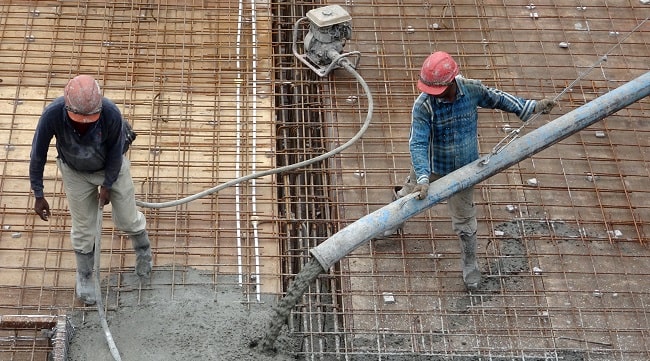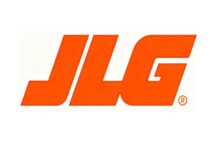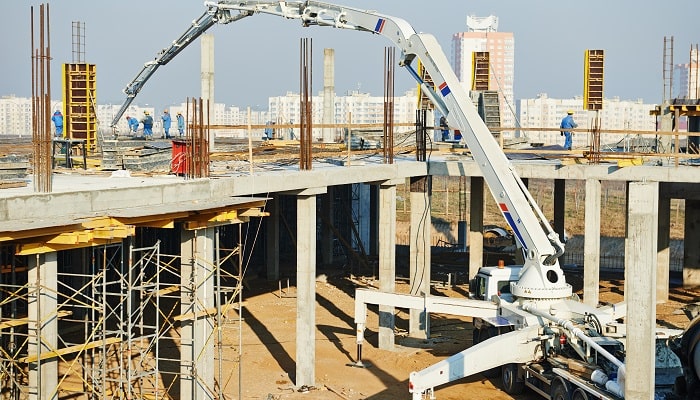Key Takeaways:
- Concrete pumping significantly enhances construction efficiency by delivering large volumes of concrete quickly and accurately, even to hard-to-reach spots.
- It improves the quality and durability of structures by ensuring consistent concrete placement and reducing the risk of segregation and waste.
- By minimizing manual labor and associated risks, concrete pumping promotes a safer and more cost-effective construction process.
Imagine the logistical nightmare of pouring concrete for a sprawling bridge or a high-rise behemoth. Buckets and wheelbarrows wouldn’t cut it. Concrete pumping emerges as the construction industry’s secret weapon, but there’s more to the story than just convenience.
That said, this guide goes beyond the mechanics of pumping. It will uncover the surprising ways concrete pumping elevates construction quality, ensuring the structures built are not just efficient marvels but enduring testaments to human ingenuity.
What Is Concrete Pumping?
Concrete pumping is all about getting that liquid concrete from the mixer truck to exactly where it needs to go on the job site. It involves this machine called a concrete pump that can efficiently and accurately deliver the concrete even to hard-to-reach spots, high up, or on massive projects. For a full rundown with examples of how pumping is used, you can check out sites like https://www.jawsconcretepumping.com/.
How Concrete Pumping Works
It all starts by mixing up that concrete in the truck. Once it’s ready to go, they pour the wet mix into the hopper of the concrete pump itself. Then the pump, using either a piston or that peristaltic squeezing method, forces the concrete through a pipeline or big hose. Depending on the specific pump type, those hoses can be flexible or rigid pipes to deliver it right where it needs to go.
Types of Concrete Pumps
Concrete pumps are essential in modern construction, offering various options to meet the specific needs of different projects. Here are the main types of concrete pumps:
Boom Pumps
Boom pumps are sophisticated machines mounted on large trucks featuring a long, flexible robotic arm known as a boom. This arm can be controlled remotely to deliver concrete to high elevations or expansive areas with pinpoint accuracy. The versatility of boom concrete pumps makes them ideal for large-scale construction projects such as high-rise buildings and bridges.
The ability to extend and maneuver the boom allows concrete to be placed precisely where needed without the use of additional equipment like cranes. This not only improves efficiency but also enhances safety by minimizing the need for workers to handle heavy materials at heights. Additionally, the precision of boom concrete pumps ensures consistent concrete placement, which is crucial for the structural integrity of large constructions.
Line Pumps
A line pump, also known as trailer-mounted pumps, offer a more versatile and mobile solution compared to boom pumps. These pumps use flexible hoses attached to the pump to transport concrete to various locations on the construction site. Line pumps are particularly suited for smaller-scale projects such as residential construction, sidewalks, driveways, and swimming pools.
Their mobility allows them to be easily moved around the site, making them ideal for projects where the concrete needs to be delivered to multiple locations. The flexibility of the hoses enables the concrete to reach confined or hard-to-access areas, ensuring precise placement. This adaptability makes a line pump an excellent choice for projects that require a high degree of maneuverability and accuracy.
Specialized Usage Pumps
Specialized usage pumps are designed to meet the unique demands of specific construction environments and applications. These pumps can be customized with features and capabilities tailored to challenging projects such as tunneling, mining, or underwater construction. For instance, in tunnel construction, specialized pumps are designed to navigate the confined spaces and challenging conditions typical of such environments.
Similarly, pumps used in mining operations must be robust and reliable to handle the demanding workload. Underwater concrete placement requires pumps that can operate efficiently below water, ensuring the concrete mix remains intact and is placed accurately. The advanced technology and customization available with specialized usage pumps enable them to perform effectively in conditions that standard pumps cannot handle, making them indispensable for certain types of projects.
Advantages Of Concrete Pumping
Concrete pumping offers numerous benefits that significantly enhance the efficiency, precision, and overall quality of construction projects. Here are the key advantages of using concrete pumping in construction:
Enhanced Precision and Accuracy
These concrete pumps deliver unparalleled precision and accuracy when placing that concrete. The boom pumps with their extendable arms and remote controls let you put the concrete exactly where it needs to go, even in those hard-to-reach spots. That pinpoint accuracy means less errors and rework. And the consistent flow from the pump ensures an even mix throughout, which is key for structural integrity on the build.
Increased Efficiency and Speed
One of the most significant advantages of concrete pumping is the increased efficiency and speed it brings to construction projects. Concrete pumps can deliver large volumes of concrete rapidly, which reduces the time required to place concrete compared to traditional methods. This efficiency is particularly beneficial for large-scale projects where timely completion is critical. The ability to pump concrete continuously without frequent interruptions allows for a smoother workflow, leading to faster project turnaround times.
Improved Safety
Safety is crucial on construction sites, and concrete pumping helps in that department. By cutting down on all that manual concrete handling, there’s way less risk of injuries from lifting and lugging around those insanely heavy materials. With boom pumps, workers can even operate the whole thing remotely from a safe distance. Pumping also reduces site congestion since you don’t need as many people transporting and placing concrete by hand. Fewer bodies moving around means fewer chances of accidents.
Cost-Effectiveness
Sure, concrete pumping gear costs more upfront than traditional methods. But the long-term savings are massive. Pumping is so efficient and fast that you need far fewer workers to get the same amount done. The pinpoint accurate placement minimizes waste and costly rework. Plus, wrapping up a construction project quicker leads to lower overhead costs from shortened timelines. The upfront investment easily pays for itself.
Impact On Construction Quality
Concrete pumping plays a pivotal role in enhancing the overall quality of a construction project. Here’s a detailed look at how concrete pumping impacts construction quality:
Better Placement and Distribution
Concrete pumping ensures superior placement and distribution of concrete across the construction site. With the precision of boom and line pumps, concrete can be delivered exactly where it is needed, even in hard-to-reach areas. This accurate placement is crucial for achieving uniformity and strength in the structural components. Take high-rise buildings or complex architectural designs for example. Being able to place concrete with laser-like precision is crucial. It ensures the structural integrity remains rock-solid from start to finish on these intricate projects.
Reduced Segregation and Waste
Concrete pumping significantly reduces the risk of segregation, where the components of the concrete mix separate during transportation and placement. That steady, controlled flow from the pump keeps the concrete mix perfectly blended and even throughout. This uniformity is key for durability and strength in the final structure. The pinpoint precision of pumping also minimizes waste – less spillage and overpouring means more efficient use of those pricey materials.
Consistency in Concrete Mix
The consistency of the concrete mix is vital for the reliability and longevity of any construction project. Concrete pumps are essential for keeping the concrete flow smooth and constant. This steady stream ensures an even mix throughout the entire structure. With this consistency, every part is built with equal quality and strength – no weak points that could jeopardize the whole thing. The uniform pouring also allows for more predictable curing, resulting in sturdy, long-lasting construction when finished.
Minimized Labor Requirements
Concrete pumping reduces the need for extensive manual labor in the transportation and placement of concrete. This labor reduction cuts costs and improves the overall quality of the work. With less manual labor involved, there’s way less chance for human error that causes inconsistencies and defects. It also saves workers’ bodies from the brutal strain, reducing injury risks and making for a safer, more efficient job site overall.
Applications Of Concrete Pumping
Concrete pumping has become a must-have in construction these days. It’s such a versatile and efficient way to deliver that concrete for all sorts of job sites. Here are the primary applications of concrete pumping:
Residential Construction
Concrete pumping is extensively used in residential construction due to its ability to deliver concrete accurately and efficiently in confined spaces and complex layouts.
- Foundations: For residential buildings, concrete pumps are crucial in pouring strong and stable foundations. The precision of pumps ensures even distribution of concrete, which is vital for the structural integrity of the home.
- Driveways and Patios: Concrete pumps facilitate the creation of smooth and durable driveways and patios. The ability to reach difficult areas with ease ensures a high-quality finish and reduces the risk of cracks and imperfections.
Commercial Construction
For those massive commercial construction projects, concrete pumping is essential. You need to deliver huge volumes of concrete quickly and with pinpoint accuracy – pumping makes that possible.
- High-Rise Buildings: Concrete pumps are indispensable in constructing high-rise buildings. Boom pumps, with their extendable arms, can deliver concrete to the upper floors efficiently, ensuring the structural elements are solid and uniform.
- Parking Structures: Concrete pumping significantly benefits the construction of multi-level parking structures. The pumps’ precision and speed help create robust floors and support structures, ensuring the longevity and safety of the parking facility.
Infrastructure Projects
Infrastructure projects, such as bridges, tunnels, and highways, require vast amounts of concrete delivered under challenging conditions. Concrete pumping effectively meets these demands.
- Bridges: Building bridges involves working at great heights, over water, or on difficult terrain. Concrete pumps can deliver concrete with precision to these locations, ensuring the bridge’s piers and decks are strong and durable.
- Tunnels: In tunnel construction, specialized pumps place concrete in the confined and often complex environments of underground projects, ensuring the stability and safety of the tunnel structure.
- Roadways and Highways: For extensive road and highway projects, concrete pumps enable the efficient pouring of concrete over large areas, helping to maintain a consistent and durable road surface.
Conclusion

While concrete may be the backbone of construction, concrete pumping is the unseen muscle that ensures its strength and longevity. This technology goes beyond convenience, offering a hidden advantage: a significant boost in construction quality. By providing consistent placement, minimizing concrete issues, and promoting faster construction times, concrete pumping allows us to build structures that are not only impressive feats of engineering but also safe and enduring testaments to human innovation.






























